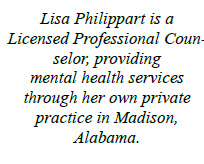 By: Lisa Philippart
By: Lisa Philippart
In my previous article, I promised you that I would address the topic of short-term anxiety. When I lived in Colorado, I received extensive training in Dialectical Behavior Therapy or DBT. One of the “pillars” of DBT is distress tolerance. Distress tolerance is a person’s ability to manage actual or perceived emotional distress. It also involves being able to make it through an emotional incident without making it worse. Those with low distress tolerance tend to become overwhelmed by stressful situations and may sometimes turn to unhealthy or even destructive ways of coping with these difficult emotions. Everyone experiences a wide range of stress and anxiety during life. These experiences can range from daily annoyances to major events such as job loss, divorce, or the death of a loved one. Whether the stress is large or small, your ability to manage distress can play a role in how you handle various situations. Learning distress tolerance skills can make an incredibly positive difference in your ability to handle difficult emotions. Let’s look at some of the various types of distress tolerance techniques from DBT.
 Distraction can be a highly effective way of taking action to increase your distress tolerance. It involves a variety of methods to take your mind off your feelings of discomfort. Improving the moment involves a variety of strategies to help make the stressful situation more tolerable. Some examples include visualizing a relaxing scene, “looking for the silver lining,” or taking a mental break to do something pleasant. Another strategy involves thinking about the potential pros and cons of either tolerating the distress or not tolerating it. It can be a useful tool for thinking through the short-term and long-term consequences of an action.
Distraction can be a highly effective way of taking action to increase your distress tolerance. It involves a variety of methods to take your mind off your feelings of discomfort. Improving the moment involves a variety of strategies to help make the stressful situation more tolerable. Some examples include visualizing a relaxing scene, “looking for the silver lining,” or taking a mental break to do something pleasant. Another strategy involves thinking about the potential pros and cons of either tolerating the distress or not tolerating it. It can be a useful tool for thinking through the short-term and long-term consequences of an action.
Rather than focusing on things that cannot be changed or that are out of your control, radical acceptance involves just accepting things as they are and letting go of feelings of regret, anger, or bitterness. (Not easy to do, I know!) And lastly, the strategy of self-soothing can be a way to calm yourself and keep negative emotions in check. Different sensory experiences that involve sight, sound, smell, taste, and touch can all be used to quiet stressful moments.

 Practicing these distress tolerance skills is the next step. Here are some suggestions:
Practicing these distress tolerance skills is the next step. Here are some suggestions:
- Get active: Do something you enjoy, such as taking a walk in a park. Think of it as, “What would you be doing now if you weren’t so upset?”
- Contributing: Get outside of yourself by focusing your attention on helping others. Volunteer at a school or local animal shelter.
- Comparing: Think of a time when you were even more emotionally distressed than you are now. How many crises have you survived? All of them!
- Opposite action: Ask yourself, “What’s the opposite feeling to the distress I’m feeling now?” Then do something to make you feel the opposite way. For example, if you’re feeling angry, watch a comedy.
- Thinking big: The idea is to fill your brain with other thoughts so there’s no room for distress. If you are in a crowd, guess each person’s profession.
- Put your body in charge: It’s based on the idea that where your body leads your emotions will follow. So get going! Run up and downstairs. If you are inside, go outside. Your body and emotions will thank you!
This information is just an overview of some of the distress tolerance skills. If you find this helpful, please take time to explore DBT further.
By: Lisa Philippart
Licensed Professional Counselor









 July 19, 2024
July 19, 2024




